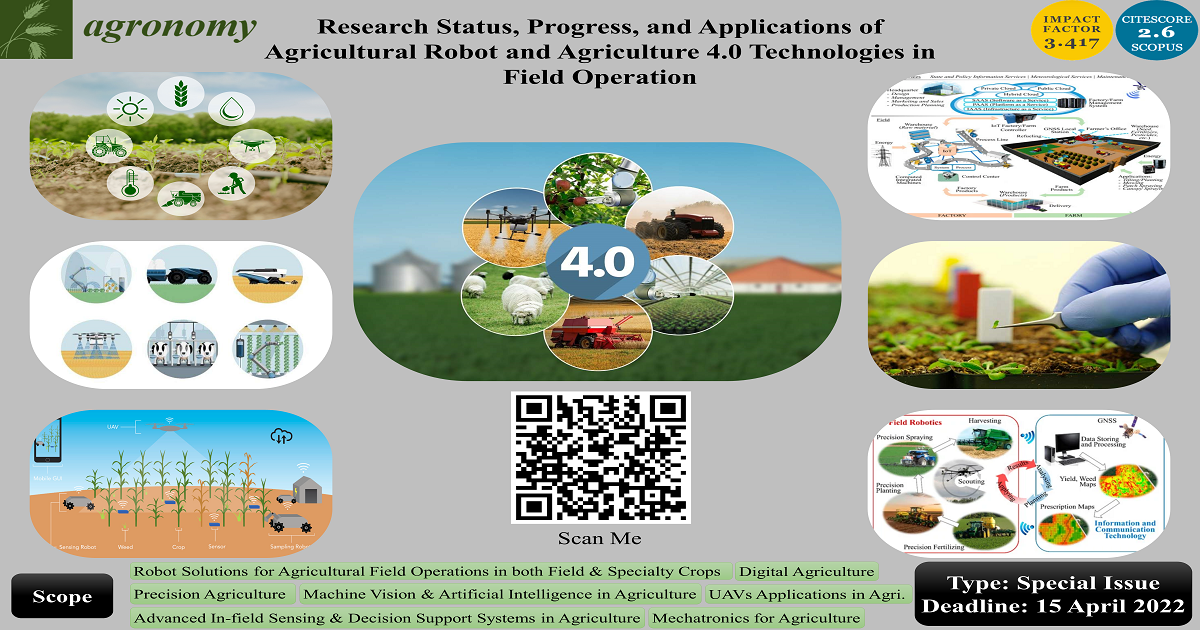Research Status, Progress, and Applications of Agricultural Robot and Agriculture 4.0 Technologies in Field Operation
A special issue of Agronomy (ISSN 2073-4395). This special issue belongs to the section "Precision and Digital Agriculture".
Deadline for manuscript submissions: closed (15 April 2022) | Viewed by 3634

Special Issue Editors
Interests: smart agriculture; fruit robotic harvesting; 2D/3D image processing; multispectral/hyperspectral imaging; spectroscopy; machine learning; deep learning
Special Issues, Collections and Topics in MDPI journals
Interests: agricultural robots; agricultural mechanics; machine vision
Special Issues, Collections and Topics in MDPI journals
Interests: agriculture robot; medical robot; infrastructural robot
Special Issues, Collections and Topics in MDPI journals
Interests: smart agriculture; agricultural robots; machine vision
Special Issues, Collections and Topics in MDPI journals
Special Issue Information
Dear Colleagues,
With the rapid increase in the world population, first agriculture has moved on from manual operation to mechanization and is now moving toward the implementation of automated/robotic field operations to meet the growing demand for food. However, in contrast to industrial operations, agricultural field operations are complex, unstructured, ill-defined, and are subject to a high degree of variation in illumination, atmospheric, and landscape conditions in addition to the dynamic biological nature of both field and specialty crops. These challenges make it extremely difficult for implementing automated/robotic solutions in agricultural field operations. However, with the technological advancements in GPS (global positioning system), smart sensors, UAVs (unmanned aerial vehicles), GIS (geographic information system), IoT (internet of things), machine vision, artificial intelligence, blockchain, big data, cybernetics, nanotechnology, digital agriculture, precision agriculture, smart decision support systems, advanced control system, etc., the use of automated/robotic operations in agriculture is becoming reality.
The focus of this issue is to collect outstanding articles focusing (but not limited to) on robot solutions for various field operations (e.g. planting, irrigation, path planning and navigation, fertilization, spraying, canopy management, pollination, thinning, pruning, weed removal, precision crop load management, harvesting, postharvest transportation, and storage) for both field and specialty crops; precision agriculture applications; advanced in-field sensing and decision support systems; machine vision, artificial intelligence, deep learning, machine learning, big data, IoT, cybernetics, nanotechnology, digital agriculture, UAVs (unmanned aerial vehicles), mechatronics, and smart sensor’s, swarm robotics, and nanorobotics applications in agriculture.
Dr. Longsheng Fu
Dr. Satoru Sakai
Dr. Chao Chen
Dr. Yaqoob Majeed
Guest Editors
Manuscript Submission Information
Manuscripts should be submitted online at www.mdpi.com by registering and logging in to this website. Once you are registered, click here to go to the submission form. Manuscripts can be submitted until the deadline. All submissions that pass pre-check are peer-reviewed. Accepted papers will be published continuously in the journal (as soon as accepted) and will be listed together on the special issue website. Research articles, review articles as well as short communications are invited. For planned papers, a title and short abstract (about 100 words) can be sent to the Editorial Office for announcement on this website.
Submitted manuscripts should not have been published previously, nor be under consideration for publication elsewhere (except conference proceedings papers). All manuscripts are thoroughly refereed through a single-blind peer-review process. A guide for authors and other relevant information for submission of manuscripts is available on the Instructions for Authors page. Agronomy is an international peer-reviewed open access monthly journal published by MDPI.
Please visit the Instructions for Authors page before submitting a manuscript. The Article Processing Charge (APC) for publication in this open access journal is 2600 CHF (Swiss Francs). Submitted papers should be well formatted and use good English. Authors may use MDPI's English editing service prior to publication or during author revisions.
Keywords
- robotics for field and specialty crops
- agricultural automation
- machine vision
- deep learning
- machine learning
- advanced in-field sensing and decision support systems
- swarm robotics
- nanorobotics
- smart sensors
- precision agriculture
- digital agriculture
- agriculture 4.0
- instrumentation
- big data
- cybernetics
- SLAM (simultaneous localization and mapping)
- ICT applications
- IoT in agriculture







